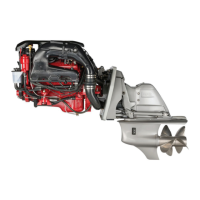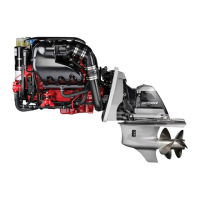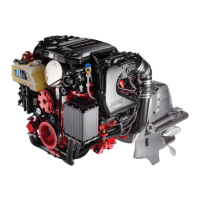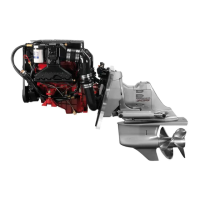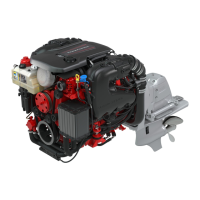Do you have a question about the Volvo Penta V8-225 and is the answer not in the manual?
Welcome message and introduction to Volvo Penta marine engines and their history.
Highlights Volvo Penta's core values: Quality, Safety, and Environmental Care.
Lists the specific Volvo Penta engine models covered by this operator's manual.
Information regarding the Forward Drive system and its relation to the manual's illustrations.
Guidance on obtaining the correct manual and understanding its content.
Explains the safety alert symbol and the meaning of signal words like DANGER, WARNING, CAUTION.
Provides essential safety guidelines and recommendations for boat operation.
Details risks and precautions related to carbon monoxide (CO) exposure on boats.
Safety advice for operating engines while the boat is stationary.
Safety measures and considerations for operating the boat while underway.
Explanation of backdrafting and its effect on CO concentration within the boat.
Information on where to find warranty details and how to obtain them.
Importance of the owner's identification card for warranty validation and service.
Details on Volvo Penta's 24/7 breakdown assistance service.
Information about the network of authorized Volvo Penta dealers for service and support.
How to find the nearest Volvo Penta dealer for assistance.
Resources and information available on the Volvo Penta website.
Contact information for Volvo Penta Customer Relations in the United States.
Description of the ignition switch, its key positions, and ordering replacement keys.
General description and function of various boat gauges (Tachometer, Speedometer, etc.).
Information on the dashboard panel that indicates engine faults and system status.
Overview of the power trim system, its benefits, and safety warnings.
How to operate the power trim controls and the function of trim gauges.
Description of different control configurations and their features.
Instructions on how to adjust the friction brake on Volvo Penta controls.
Explanation of the ACPS, its function, and LED indicator status.
Information on the hot water outlet system and its impact on engine operation.
Essential checks to perform before starting the engine for safe operation.
Recommended tools and spare parts to have onboard for safety and maintenance.
Step-by-step guide for pre-start checks and procedures.
Instructions on how to start the engine, including audible alarm functions.
Steps to clear a flooded engine and start it successfully.
Guidance on special operating procedures for the first 20 hours of engine use.
Advice on monitoring gauges and alarms for potential engine issues.
Explanation of the alarm system and common engine malfunctions it indicates.
Safety precautions for maneuvering the boat, especially regarding propellers.
How to operate the control lever for shifting gears and controlling engine speed.
Instructions on using the safety lanyard (emergency stop switch) correctly.
Recommended cruising speeds for different engine models.
Explanation of the trim system's role in maneuvering and its components.
Detailed instructions on using the trim controls and understanding trim ranges.
Definition of Trim, Beach, and Tilt ranges for different drive types.
Guidance on adjusting trim for optimal boat performance and ride comfort.
How to use trim to get the boat on plane during acceleration.
Describes the effects and safety considerations of bow-up and bow-down trim positions.
Information on the trim/tilt motor's thermal overload protection.
Function of the neutral interlock button on side-mount controls.
How to disengage gear shifting to use the control lever for throttle only.
Guidance on operating the boat's steering system and potential issues.
Information on steering systems for twin-engine setups.
Procedures for preparing the boat and engine for periods of inactivity.
Procedures for operating the boat in special conditions like freezing temperatures.
How to use trim/tilt for shallow water operation and associated risks.
Considerations for operating in high altitudes and salt water environments.
Safety and operational advice for high-speed boat handling.
Planning and procedures before stopping the engine, including maneuvering.
Steps for safely stopping the engine after operation.
Instructions for flushing the engine with fresh water after use.
Recommended drive position when the boat is stored.
Steps and precautions for trailering the boat, including drive handling.
Procedure for draining raw water cooled engines to prevent freeze damage.
Procedure for draining the raw water side of closed cooling systems.
Safety warnings and procedures for when the boat strikes an object or runs aground.
Explanation of the trim/tilt system's impact protection feature.
Inspection and maintenance of the tie rod for twin-engine steering systems.
Procedures and recommendations following engine submersion in water.
Instructions for jump-starting a drained battery using auxiliary batteries.
General approach to troubleshooting engine malfunctions and gathering information.
Checks for issues preventing the engine from cranking.
Troubleshooting steps for when the engine cranks but fails to start.
Checks related to the fuel system that may cause starting or running issues.
Diagnosing and resolving issues with hard starting in cold or hot engine conditions.
Checks for problems preventing the engine from reaching its expected RPM.
Troubleshooting for low oil pressure and engine knocking sounds.
Procedures for charging and preventing low battery voltage after storage.
Factors affecting performance and troubleshooting reduced power or speed.
How hull weight affects boat performance and potential issues.
Explanation of Engine Protection Mode and how it activates.
Specific troubleshooting for low oil pressure alarms and conditions.
Diagnosing and addressing engine overheating situations.
Troubleshooting water detection in the drive unit's bellows.
Diagnosing alarms related to water in oil or low oil level in the drive unit.
Troubleshooting electric fuel pump operation and potential issues.
Locating and checking fuses and relays in the engine's electrical system.
Interpreting engine status panel indicators and required operator responses.
Checks for issues with the power trim system, including fuses and blockages.
Checks for common problems affecting the boat's steering system.
Interpreting the status of the ACPS based on LED indicators.
Understanding and troubleshooting static water line problems and water ingestion.
Procedure for testing the static water line to ensure proper engine protection.
Outlines the owner's duties in maintaining the engine and power package.
Information regarding warranty and maintenance of emissions control systems.
Importance of checklists for safe boat operation and preventative maintenance.
Checklists for owner maintenance tasks performed before each use and monthly.
Recommendations for scheduled maintenance performed by authorized dealers.
The importance of the hour meter for tracking maintenance intervals.
Schedule of annual maintenance tasks or tasks performed every 100 hours.
Continuation of annual service tasks, including drive and miscellaneous checks.
Guidelines for performing basic maintenance and repairs yourself.
Warnings and recommendations regarding the use of genuine Volvo Penta parts.
Special maintenance and service requirements for certified engines.
General maintenance procedures for the engine, including serpentine belt.
Importance and procedure for engine alignment, typically done by a dealer.
Guidelines for engine oil changes, types, and intervals.
Procedures for adding engine oil during break-in and after.
General maintenance and safety precautions for the fuel system.
Measures to prevent ethanol from damaging the fuel system.
Step-by-step instructions for replacing the engine fuel filter.
Procedure for treating fuel for storage to prevent ethanol damage.
Procedure for preparing the engine and fuel system for storage.
Information on the EFI system and when to contact a dealer for issues.
Instructions for replacing the engine thermostat on raw water cooled engines.
Procedure for inspecting and replacing the water pump impeller.
Checking coolant levels and type in freshwater cooling systems.
How to check engine coolant for adequate freeze protection.
Procedure for replacing sacrificial anodes in the heat exchanger.
Checking exhaust bellows and clamps for safety and integrity.
Inspection and replacement of exhaust manifold anodes.
Basic maintenance for the ignition system, including cap and rotor.
Checking the distributor cap and rotor for corrosion.
Guidance on replacing spark plugs and ensuring proper performance.
Procedures for battery maintenance, replacement, and safety precautions.
Checks and procedures related to the drive unit, including lubricant and painting.
Information on the power trim/tilt fluid and when to consult a dealer.
Clearing debris from the pitot tube to ensure speedometer function.
How to inspect and replace sacrificial anodes on the drive unit.
Steps to reset the oil sensor on OceanX drives after oil changes.
Guidelines for propeller care, inspection, and replacement procedures.
Checking and maintaining the power steering reservoir fluid level.
General importance of proper preparation for engine and drive storage.
Specific steps for storing the boat and engine for short periods.
Procedures and recommendations for winterizing the engine and drive for long-term storage.
A checklist of tasks to perform when launching the boat after storage.
Table detailing engine displacement, RPM range, firing order, and other specifications.
Requirements and recommendations for engine oil quality and type.
Specifies the minimum octane rating required for the gasoline fuel.
Guidelines for using ethanol-blended fuels and potential issues.
Information specific to the US regarding fuel types like E15.
Advice on fuel system care and warnings against using methanol in fuel.
Specifies the recommended coolant type and mixing instructions.
Requirements for battery type, cold cranking amps, and reserve capacity.
Details on drive unit lubrication capacity and type.
Location of identification numbers for engine, transom shield, and drive unit.
Manufacturer's declaration regarding engine compliance with emission and sound standards.
Welcome message and introduction to Volvo Penta marine engines and their history.
Highlights Volvo Penta's core values: Quality, Safety, and Environmental Care.
Lists the specific Volvo Penta engine models covered by this operator's manual.
Information regarding the Forward Drive system and its relation to the manual's illustrations.
Guidance on obtaining the correct manual and understanding its content.
Explains the safety alert symbol and the meaning of signal words like DANGER, WARNING, CAUTION.
Provides essential safety guidelines and recommendations for boat operation.
Details risks and precautions related to carbon monoxide (CO) exposure on boats.
Safety advice for operating engines while the boat is stationary.
Safety measures and considerations for operating the boat while underway.
Explanation of backdrafting and its effect on CO concentration within the boat.
Information on where to find warranty details and how to obtain them.
Importance of the owner's identification card for warranty validation and service.
Details on Volvo Penta's 24/7 breakdown assistance service.
Information about the network of authorized Volvo Penta dealers for service and support.
How to find the nearest Volvo Penta dealer for assistance.
Resources and information available on the Volvo Penta website.
Contact information for Volvo Penta Customer Relations in the United States.
Description of the ignition switch, its key positions, and ordering replacement keys.
General description and function of various boat gauges (Tachometer, Speedometer, etc.).
Information on the dashboard panel that indicates engine faults and system status.
Overview of the power trim system, its benefits, and safety warnings.
How to operate the power trim controls and the function of trim gauges.
Description of different control configurations and their features.
Instructions on how to adjust the friction brake on Volvo Penta controls.
Explanation of the ACPS, its function, and LED indicator status.
Information on the hot water outlet system and its impact on engine operation.
Essential checks to perform before starting the engine for safe operation.
Recommended tools and spare parts to have onboard for safety and maintenance.
Step-by-step guide for pre-start checks and procedures.
Instructions on how to start the engine, including audible alarm functions.
Steps to clear a flooded engine and start it successfully.
Guidance on special operating procedures for the first 20 hours of engine use.
Advice on monitoring gauges and alarms for potential engine issues.
Explanation of the alarm system and common engine malfunctions it indicates.
Safety precautions for maneuvering the boat, especially regarding propellers.
How to operate the control lever for shifting gears and controlling engine speed.
Instructions on using the safety lanyard (emergency stop switch) correctly.
Recommended cruising speeds for different engine models.
Explanation of the trim system's role in maneuvering and its components.
Detailed instructions on using the trim controls and understanding trim ranges.
Definition of Trim, Beach, and Tilt ranges for different drive types.
Guidance on adjusting trim for optimal boat performance and ride comfort.
How to use trim to get the boat on plane during acceleration.
Describes the effects and safety considerations of bow-up and bow-down trim positions.
Information on the trim/tilt motor's thermal overload protection.
Function of the neutral interlock button on side-mount controls.
How to disengage gear shifting to use the control lever for throttle only.
Guidance on operating the boat's steering system and potential issues.
Information on steering systems for twin-engine setups.
Procedures for preparing the boat and engine for periods of inactivity.
Procedures for operating the boat in special conditions like freezing temperatures.
How to use trim/tilt for shallow water operation and associated risks.
Considerations for operating in high altitudes and salt water environments.
Safety and operational advice for high-speed boat handling.
Planning and procedures before stopping the engine, including maneuvering.
Steps for safely stopping the engine after operation.
Instructions for flushing the engine with fresh water after use.
Recommended drive position when the boat is stored.
Steps and precautions for trailering the boat, including drive handling.
Procedure for draining raw water cooled engines to prevent freeze damage.
Procedure for draining the raw water side of closed cooling systems.
Safety warnings and procedures for when the boat strikes an object or runs aground.
Explanation of the trim/tilt system's impact protection feature.
Inspection and maintenance of the tie rod for twin-engine steering systems.
Procedures and recommendations following engine submersion in water.
Instructions for jump-starting a drained battery using auxiliary batteries.
General approach to troubleshooting engine malfunctions and gathering information.
Checks for issues preventing the engine from cranking.
Troubleshooting steps for when the engine cranks but fails to start.
Checks related to the fuel system that may cause starting or running issues.
Diagnosing and resolving issues with hard starting in cold or hot engine conditions.
Checks for problems preventing the engine from reaching its expected RPM.
Troubleshooting for low oil pressure and engine knocking sounds.
Procedures for charging and preventing low battery voltage after storage.
Factors affecting performance and troubleshooting reduced power or speed.
How hull weight affects boat performance and potential issues.
Explanation of Engine Protection Mode and how it activates.
Specific troubleshooting for low oil pressure alarms and conditions.
Diagnosing and addressing engine overheating situations.
Troubleshooting water detection in the drive unit's bellows.
Diagnosing alarms related to water in oil or low oil level in the drive unit.
Troubleshooting electric fuel pump operation and potential issues.
Locating and checking fuses and relays in the engine's electrical system.
Interpreting engine status panel indicators and required operator responses.
Checks for issues with the power trim system, including fuses and blockages.
Checks for common problems affecting the boat's steering system.
Interpreting the status of the ACPS based on LED indicators.
Understanding and troubleshooting static water line problems and water ingestion.
Procedure for testing the static water line to ensure proper engine protection.
Outlines the owner's duties in maintaining the engine and power package.
Information regarding warranty and maintenance of emissions control systems.
Importance of checklists for safe boat operation and preventative maintenance.
Checklists for owner maintenance tasks performed before each use and monthly.
Recommendations for scheduled maintenance performed by authorized dealers.
The importance of the hour meter for tracking maintenance intervals.
Schedule of annual maintenance tasks or tasks performed every 100 hours.
Continuation of annual service tasks, including drive and miscellaneous checks.
Guidelines for performing basic maintenance and repairs yourself.
Warnings and recommendations regarding the use of genuine Volvo Penta parts.
Special maintenance and service requirements for certified engines.
General maintenance procedures for the engine, including serpentine belt.
Importance and procedure for engine alignment, typically done by a dealer.
Guidelines for engine oil changes, types, and intervals.
Procedures for adding engine oil during break-in and after.
General maintenance and safety precautions for the fuel system.
Measures to prevent ethanol from damaging the fuel system.
Step-by-step instructions for replacing the engine fuel filter.
Procedure for treating fuel for storage to prevent ethanol damage.
Procedure for preparing the engine and fuel system for storage.
Information on the EFI system and when to contact a dealer for issues.
Instructions for replacing the engine thermostat on raw water cooled engines.
Procedure for inspecting and replacing the water pump impeller.
Checking coolant levels and type in freshwater cooling systems.
How to check engine coolant for adequate freeze protection.
Procedure for replacing sacrificial anodes in the heat exchanger.
Checking exhaust bellows and clamps for safety and integrity.
Inspection and replacement of exhaust manifold anodes.
Basic maintenance for the ignition system, including cap and rotor.
Checking the distributor cap and rotor for corrosion.
Guidance on replacing spark plugs and ensuring proper performance.
Procedures for battery maintenance, replacement, and safety precautions.
Checks and procedures related to the drive unit, including lubricant and painting.
Information on the power trim/tilt fluid and when to consult a dealer.
Clearing debris from the pitot tube to ensure speedometer function.
How to inspect and replace sacrificial anodes on the drive unit.
Steps to reset the oil sensor on OceanX drives after oil changes.
Guidelines for propeller care, inspection, and replacement procedures.
Checking and maintaining the power steering reservoir fluid level.
General importance of proper preparation for engine and drive storage.
Specific steps for storing the boat and engine for short periods.
Procedures and recommendations for winterizing the engine and drive for long-term storage.
A checklist of tasks to perform when launching the boat after storage.
Table detailing engine displacement, RPM range, firing order, and other specifications.
Requirements and recommendations for engine oil quality and type.
Specifies the minimum octane rating required for the gasoline fuel.
Guidelines for using ethanol-blended fuels and potential issues.
Information specific to the US regarding fuel types like E15.
Advice on fuel system care and warnings against using methanol in fuel.
Specifies the recommended coolant type and mixing instructions.
Requirements for battery type, cold cranking amps, and reserve capacity.
Details on drive unit lubrication capacity and type.
Location of identification numbers for engine, transom shield, and drive unit.
Manufacturer's declaration regarding engine compliance with emission and sound standards.
| Brand | Volvo Penta |
|---|---|
| Model | V8-225 |
| Category | Engine |
| Language | English |
